Manufactured in 1969, this Ford Mustang Boss 429 is one of a limited production run of about 850 units designed for that model year. It bears the identification Kar Kraft number KK1934. The vehicle was initially dispatched to Rice and Holman Ford, located in Pennsauken, New Jersey. Impressively, it is noted that the original owner retained possession until the year 2013. The car underwent restoration work during the 2000s, a project reportedly undertaken by Anghel Restorations based in Arizona. In 2014, the selling dealer acquired the vehicle, which later gained prominence through a feature on Jay Leno’s Garage in June 2016.

Adorned in its original Candyapple Red hue with black Clarion Knit vinyl upholstery, this automobile rolled out of the factory. Powering it is a robust 429ci V8 engine paired with a close-ratio four-speed manual transmission and a Traction-Lok differential. Notable among the factory-installed features are the competition suspension, power-assisted front disc brakes, power steering, a trunk-mounted battery, color-keyed racing mirrors, a front spoiler, a Philco AM radio, a center console, and the Visibility and Interior Decor-Deluxe groups.
This specific Boss 429 comes with a comprehensive package. It includes documents such as a build sheet, factory invoice, original sales paperwork, and an Ownercard, along with factory literature, an Elite Marti Report, photos showcasing the refurbishment process, records, and a Pennsylvania title.
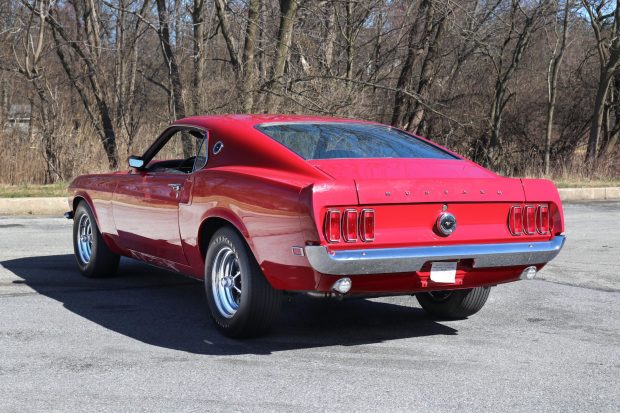
The Boss 429 was offered for the 1969 and 1970 model years in order to homologate the 429 engine for use in NASCAR. Production was completed by Kar Kraft of Brighton, Michigan, and each example was given a serialized number. This example was assigned serial number KK1934 and delivered new in Candyapple Red (T). Its SportsRoof body was stripped, placed on a rotisserie, and received bodywork in the 2000s, including a replacement left door skin, before it was repainted. Features include chrome bumpers, a hood scoop, a front spoiler, driving lamps, Boss 429 fender badging, color-keyed racing mirrors, quarter panel scoops, reverse lights, and a dual-outlet exhaust that exits below the rear bumper.
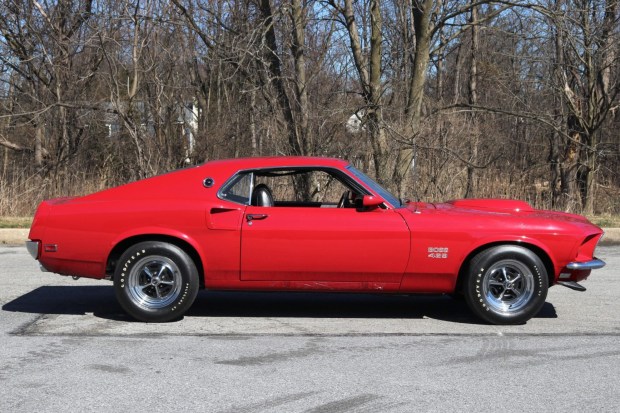
The 15″ Magnum 500 wheels are mounted with raised-letter Goodyear Polyglas GT F60-15 tires. The Boss 429 model was equipped with revised control arms, a higher-rate front anti-roll bar than other Mustang variants, a rear anti-roll bar, and staggered rear shock absorbers. Power-assisted brakes with discs up front and drums out back were standard on the 429, with the front brakes reinforced with heavy-duty hubs and rotors as well as oversized spindles. Power-assisted steering was also equipped from the factory.
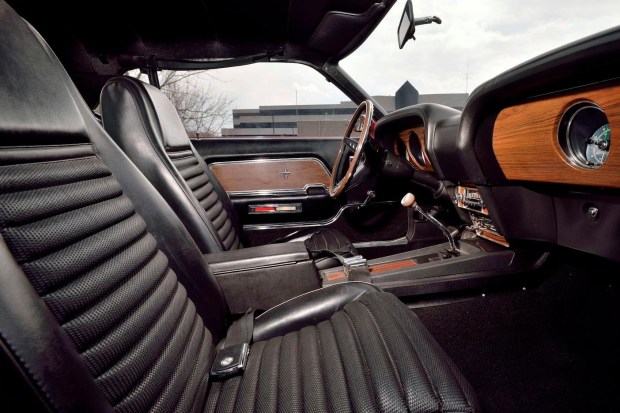
The cabin features high-back bucket seats trimmed in black Clarion Knit vinyl along with a matching rear bench, color-keyed carpets, and simulated woodgrain appliqués on the dash, console, and deluxe door panels. The car was optioned with the Interior Decor Group–Deluxe and Visibility Group packages, and it features a Philco AM radio, a dash-mounted rally clock, deluxe seat belts, and courtesy lights for the glovebox, ashtray, trunk, and other areas.

The woodgrain-rimmed steering wheel frames a 120-mph speedometer, an 8k-rpm tachometer, and gauges for coolant temperature and fuel level. Controls for the choke and hood scoop are located on a steel bracket mounted above the accelerator pedal on the lower dash area. The five-digit odometer is said to show 49k miles. Total mileage is unknown.
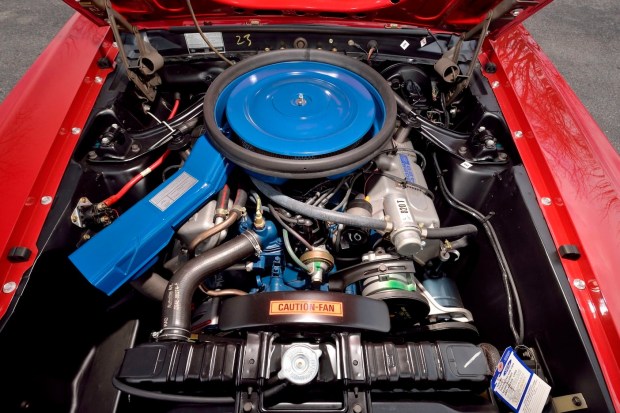
Kar Kraft was commissioned by Ford to modify Cobra Jet Mustangs with a larger 429ci V8 featuring “crescent”-shaped combustion chambers. It came from the factory with an aluminum intake manifold and a four-barrel Holley 735-cfm carburetor.
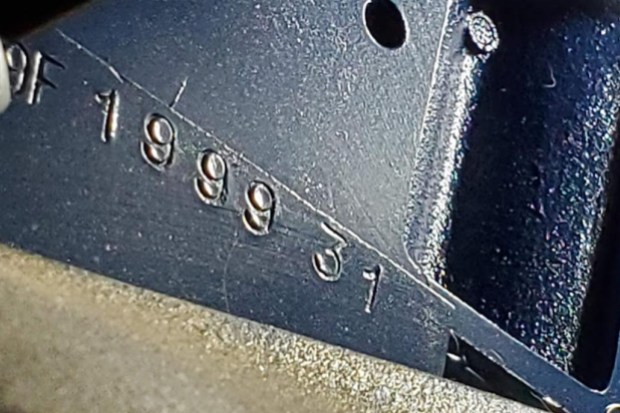
An engine stamping featuring a 9F prefix corresponding to a 1969 Ford along with the last six digits of the car’s serial number sequence can be seen above.
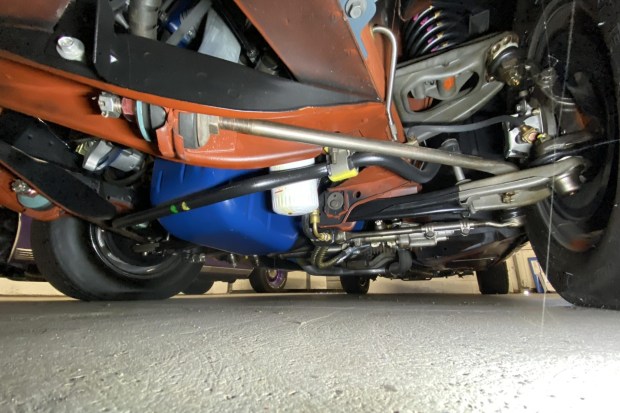
Power is sent to the rear wheels via a four-speed manual transmission, a balanced driveshaft unique to the Boss 429, a 9″ rear end, and a Traction-Lok limited-slip differential. Factory-style markings and areas of red oxide primer on the underbody can be seen in the gallery.

Refurbishment photos can be seen in the gallery along with photos taken during the 2016 filming of Jay Leno’s Garage.
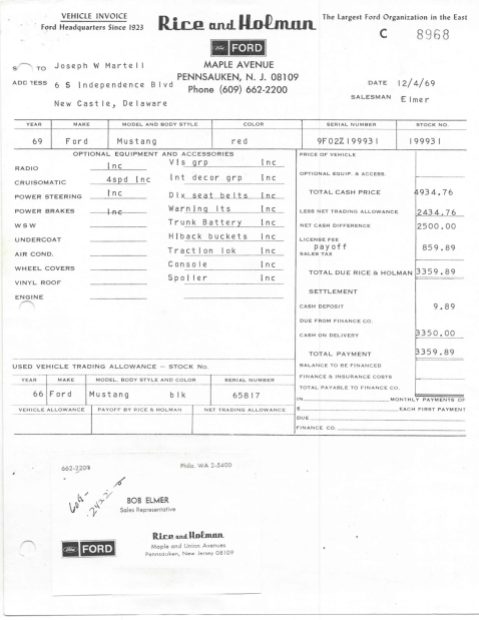
The original sales invoice is dated December 4, 1969, and lists optional equipment as well as a total price of $4,934. The build sheet, a factory invoice, and a copy of the original order sheet can be seen in the gallery.
Video





